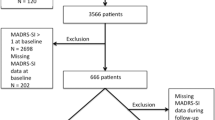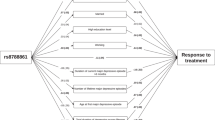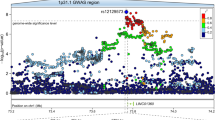Abstract
Increasing amounts of data suggest that affective disorders might be related to dysregulation of the hypothalamic–pituitary–adrenal (HPA) axis, one of the stress-response systems. Arginine vasopressin (AVP) influences several symptoms, relevant to affective disorders, notable memory processes, pain sensitivity, synchronization of biological rhythms and the timing and quality of REM sleep. We examined whether genetic variations in the AVP receptor 1b gene (AVPR1b) could be associated with increased susceptibility to affective disorders using a gene-based association analysis of single-nucleotide polymorphisms (SNPs). Five SNPs were identified in AVPR1b and genotyped in two well-diagnosed samples of patients with recurrent major depression and matched controls. In the Swedish sample, we observed significant allele (P=0.02) and genotype (P=0.01) association with SNP AVPR1b-s3, and in the Belgian sample, a borderline significant association with SNP AVPR1b-s5 (P=0.04). In both patient–control samples, the haplotype defined by alleles A-T-C-A-G for the AVPR1b-s SNPs s1-s2-s3-s4-s5 was significantly over-represented in controls compared to patients. Our data support a protective effect of this major haplotype for recurrent major depression.
This is a preview of subscription content, access via your institution
Access options
Subscribe to this journal
Receive 12 print issues and online access
$259.00 per year
only $21.58 per issue
Buy this article
- Purchase on Springer Link
- Instant access to full article PDF
Prices may be subject to local taxes which are calculated during checkout


Similar content being viewed by others
References
Dinan TG . Glucocorticoids and the genesis of depressive illness. A psychobiological model. Br J Psychiatry 1994; 164: 365–371.
Carroll BJ, Feinberg M, Greden JF, Tarika J, Albala AA, Haskett RF et al. A specific laboratory test for the diagnosis of melancholia. Standardization, validation, and clinical utility. Arch Gen Psychiatry 1981; 38: 15–22.
Nemeroff CB, Krishnan KR, Reed D, Leder R, Beam C, Dunnick NR . Adrenal gland enlargement in major depression. A computed tomographic study. Arch Gen Psychiatry 1992; 49: 384–387.
Von Bardeleben U, Stalla GK, Muller OA, Holsboer F . Blunting of ACTH response to human CRH in depressed patients is avoided by metyrapone pretreatment. Biol Psychiatry 1988; 24: 782–786.
Licinio J, Gold PW . Role of corticotrophin releasing hormone 41 in depressive illness. Baillieres Clin Endocrinol Metab 1991; 5: 51–58.
Charlton BG, Ferrier IN . Hypothalamo-pituitary-adrenal axis abnormalities in depression: a review and a model. Psychol Med 1989; 19: 331–336.
Gold PW, Goodwin FK, Reus VI . Vasopressin in affective illness. Lancet 1978; 1: 1233–1236.
Von Bardeleben U, Holsboer F . Cortisol response to a combined dexamethasone-human corticotropin-releasing hormone challenge in patients with depression. J Neuroendocrinol 1989; 1: 485–488.
Lim AT . Corticotropine releasing factor (CRF). In: Fink G (ed). Encyclopedia of Stress. Academic Press: London, 2000, pp 578–581.
Jard S, Gaillard RC, Guillon G, Marie J, Schoenenberg P, Muller AF et al. Vasopressin antagonists allow demonstration of a novel type of vasopressin receptor in the rat adenohypophysis. Mol Pharmacol 1986; 30: 171–177.
Barberis C, Audigier S, Durroux T, Elands J, Schmidt A, Jard S . Pharmacology of oxytocin and vasopressin receptors in the central and peripheral nervous system. Ann NY Acad Sci 1992; 652: 39–45.
Birnbaumer M . Vasopressin receptors. Trends Endocrinol Metab 2000; 11: 406–410.
Tribollet E . Vasopressin and oxytocin receptors in the rat brain. In: Bjorklund A, Hokfelt T, Kuhar MJ (eds). Handbook of Chemical Neuroanatomy, Vol 11. Elsevier: New York, 1992, pp 289–320.
Lolait SJ, O'Carroll AM, Mahan LC, Felder CC, Button DC, Young WS et al. Extrapituitary expression of the rat V1b vasopressin receptor gene. Proc Natl Acad Sci USA 1995; 92: 6783–6787.
Grazzini E, Lodboerer AM, Perez-Martin A, Joubert D, Guillon G . Molecular and functional characterization of V1b vasopressin receptor in rat adrenal medulla. Endocrinology 1996; 137: 3906–3914.
Sugimoto T, Saito M, Mochizuki S, Watanabe Y, Hashimoto S, Kawashima H . Molecular cloning and functional expression of a cDNA encoding the human V(1b) vasopressin receptor. J Biol Chem 1994; 269: 27088–27092.
Sheehan DV, Lecrubier Y, Sheehan KH, Amorim P, Janavs J, Weiler E . The Mini-International Neuropsychiatric Interview (M.I.N.I.): the development and validation of a structured diagnostic psychiatric interview for DSM-IV and ICD-10. J Clin Psychiatry 1998; 59(Suppl): 22–33.
American Psychiatric Association (APA). Diagnostic and Statistical Manual for Mental Disorders. APA: Washington, DC, 1994.
Nilsson LG, Bäckman L, Engrund K, Nyberg L, Adofsson R, Bucht G et al. The Betula Prospective Cohort Study: memory, health and aging. Aging, Neuropsychol Cognition 1997; 4: 1–32.
Andreasen NC, Endicott J, Spitzer RL, Winokur G . The family history method using diagnostic criteria. Reliability and validity. Arch Gen Psychiatry 1977; 34: 1229–1235.
Raymond M, Rousset F . GENEPOP (version 1.2). A population genetics software for exact tests and ecumenicism. J Hered 1995; 86: 248–249.
Schneider S, Roessli D, Excoffier L, Arlequin ver. 2.000. A software for population genetics data analysis. Webpage http://lgb.unige.ch/arlequin/ 2000.
Fallin D, Schork NJ . Accuracy of haplotype frequency estimation for biallelic loci, via the expectation-maximization algorithm for unphased diploid genotype data. Am J Hum Genet 2000; 67: 947–959.
Zhao JH, Curtis D, Sham PC . Model-free analysis and permutation tests for allelic assocations. Hum Hered 2000; 50: 133–139.
Fallin D, Cohen A, Essioux L, Chumakov I, Blumenfeld M, Cohen D . Genetic analysis of case/control data using estimated haplotype frequencies:application to APOE locus variation and Alzheimer's disease. Genome Res 2001; 11: 143–151.
Tishkoff SA, Pakstis AJ, Ruano G, Kidd KK . The accuracy of statistical methods for estimation of haplotype frequencies: an example from the CD4 locus. Am J Hum Genet 2000; 67: 518–522.
Zaykin DV, Westfall PH, Young SS, Karnoub MA, Wagner MJ, Ehm MG . Testing association of statistically inferred haplotypes with discrete and continuous traits in samples of unrelated individuals. Hum Hered 2002; 53: 79–91.
Zubenko GS, Hughes HB, Maher BS, Stiffles JS, Zubenko WN, Marazita ML . Genetic linkage of region containing the CREB1 gene to depressive disorders in women from families with recurrent, early-onset, major depression. Am J Med Gen 2002; 114: 980–987.
Acknowledgements
We acknowledge the VIB Genetic Service Facility (http://www.vibgeneticservicefacility.be/) for their excellent support with the genetic analyses. The project was in part funded by the Special Research Fund of the University of Antwerp (UA), the Fund for Scientific Research (FWO and FNRS) and the Interuniversity Attraction Poles program P5/19 of the Federal Office for Scientific, Technical and Cultural Affairs, Belgium. The Torsten and Ragnar Söderbergs Foundation, Medical Research Council K2001-21X-10412-09A and The County Council of Västerbotten, Sweden supported the ascertainment of the Swedish patient–control sample.
Author information
Authors and Affiliations
Corresponding author
Rights and permissions
About this article
Cite this article
van West, D., Del-Favero, J., Aulchenko, Y. et al. A major SNP haplotype of the arginine vasopressin 1B receptor protects against recurrent major depression. Mol Psychiatry 9, 287–292 (2004). https://doi.org/10.1038/sj.mp.4001420
Received:
Revised:
Accepted:
Published:
Issue Date:
DOI: https://doi.org/10.1038/sj.mp.4001420
Keywords
This article is cited by
-
Genomic analysis of arginine vasopressin gene in riverine buffalo reveals its potential association with silent estrus behavior
Molecular Biology Reports (2022)
-
Genetic Approaches to Hypothalamic-Pituitary-Adrenal Axis Regulation
Neuropsychopharmacology (2016)
-
Role of the vasopressin 1b receptor in rodent aggressive behavior and synaptic plasticity in hippocampal area CA2
Molecular Psychiatry (2015)
-
The association of proopiomelanocortin polymorphisms with the risk of major depressive disorder and the response to antidepressants via interactions with stressful life events
Journal of Neural Transmission (2015)
-
Epigenetic Mechanisms for the Early Environmental Regulation of Hippocampal Glucocorticoid Receptor Gene Expression in Rodents and Humans
Neuropsychopharmacology (2013)



